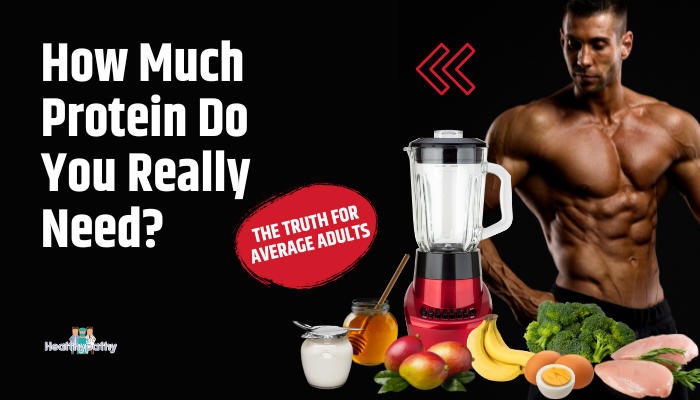Introduction
Protein is often at the center of health and fitness discussions, with many touting high-protein diets for muscle gains, weight management, or overall wellness. However, confusion arises about exactly how much is necessary—especially for the “average” adult who doesn’t bodybuild professionally or follow extreme exercise regimens.
This guide clarifies recommended protein intake, explains factors that influence protein requirements, and offers practical tips to ensure you get enough (but not too much) in your daily diet.
Why Protein Matters
Building and Repairing Tissues
Protein’s amino acids are the building blocks of muscles, organs, hair, and nails. They also help in repairing tissues after stress or injury—like post-exercise microtears or daily wear-and-tear.
Hormone and Enzyme Production
Proteins are crucial for enzyme formation (which facilitate chemical reactions) and hormones (which regulate bodily functions). Adequate protein ensures these processes function smoothly.
Satiety and Weight Management
Compared to carbs and fats, protein can enhance fullness, preventing overeating. Many use balanced protein intake to support weight control, though total calorie balance remains key.
Recommended Protein Intake Guidelines
General Recommendations
For a healthy adult with moderate physical activity, experts typically suggest:
- 0.8 g of protein per kilogram of body weight per day (or about 0.36 g per pound).
For instance, a 150-pound (68 kg) person would need around 54 g of protein daily. This baseline meets the average adult’s general requirements to prevent deficiency.
Adjusting for Different Needs
- Active Adults or Athletes: May require 1.2–2.0 g/kg body weight daily to support muscle repair and performance.
- Older Adults: After ~65 years, protein needs may rise slightly (1.0–1.2 g/kg) to preserve muscle mass and strength.
- Weight Loss Goals: A modestly higher protein intake can help reduce cravings and maintain lean muscle. However, it’s crucial to keep within overall calorie needs.
Individual Variations
Factors like metabolism, activity level, muscle mass, and health status (e.g., pregnancy or certain medical conditions) can modify protein demands. Consult a healthcare professional or dietitian for personalized targets if uncertain.
How to Meet Daily Protein Needs
Whole Food Sources
- Lean Meats and Poultry: Chicken breast or turkey offers high protein with comparatively low saturated fat.
- Fish and Seafood: Salmon, tuna, shrimp are loaded with protein and beneficial omega-3 fats.
- Eggs: A versatile choice (about 6 g protein per egg) plus essential nutrients.
- Dairy: Greek yogurt, cottage cheese, or milk supply quality protein.
- Plant-Based: Beans, lentils, tofu, tempeh, seitan, nuts, seeds—excellent for vegetarians or flexitarians.
Balanced Distribution
Aim for some protein at each meal—like 15–30 g—rather than one huge serving at dinner. Spreading intake optimizes muscle protein synthesis and satiety throughout the day.
Supplement Considerations
Protein shakes or bars can be convenient. Choose reputable brands with minimal added sugars. However, real food typically provides more micronutrients, fiber, and satiety.
Avoiding Excess Protein Pitfalls
Potential Kidney Strain
In healthy individuals, moderate to slightly high protein diets are generally safe. But for those with kidney problems, excessive protein can stress renal function. Always check with a doctor if you have kidney issues.
Hidden Calories
High-protein foods can be calorie-dense (like fattier cuts of meat). Overconsumption can stall weight goals if total calories exceed what you burn daily. Seek lean protein choices and mind portion sizes.
Balance with Other Nutrients
Focusing solely on protein can overshadow the importance of complex carbs, healthy fats, vitamins, and minerals. Aim for a well-rounded approach featuring vegetables, fruits, and whole grains alongside protein.
Practical Tips for an Optimal Protein Intake
- Plan Meals: Start each day ensuring you’ll include a protein source at breakfast, lunch, and dinner (plus snacks if needed).
- Diversify Sources: Rotate between animal-based and plant-based proteins for a broader nutrient profile.
- Watch Cooking Methods: Grilling, baking, or steaming can preserve nutrient quality without excess fat.
- Evaluate Supplements: If you struggle to meet daily goals through whole foods, consider a protein powder or bar—but read ingredient labels for sugar or artificial additives.
Frequently Asked Questions
Can I exceed 1 g of protein per pound of bodyweight?
For many recreational exercisers, 0.8–1.0 g/pound might be enough. Elite athletes or bodybuilders sometimes go higher. However, well above 1.0 g/pound may offer diminishing returns and could stress the kidneys if extremely high.
Is plant protein inferior to animal protein?
Plant sources can be slightly lower in certain essential amino acids, but combining varied plant proteins (like beans with grains) can achieve a complete amino acid profile. It’s about total variety and quality.
Do older adults need more protein than younger adults?
Yes. Aging can accelerate muscle loss. Slightly higher protein intake (around 1.0–1.2 g/kg bodyweight) may help preserve lean mass and strength.
Is protein timing important for average adults?
Spreading protein through the day helps maintain muscle repair and satiety better than one large bolus. If you do intense workouts, a post-exercise protein source (within an hour) may aid recovery.
Conclusion
While the protein conversation often conjures images of bodybuilders chugging shakes, everyday adults also rely on this vital macronutrient for tissue repair, enzyme function, and sustained energy. An intake of 0.8 g/kg of body weight is a starting guideline for generally healthy, moderately active individuals—though certain populations may benefit from more. Importantly, protein intake works best as part of a balanced diet with plenty of whole foods, vegetables, and healthy fats. By assessing your personal needs, diversifying sources, and watching portion sizes, you’ll hit that sweet spot—enough protein to maintain and enhance well-being without going overboard.
References
- National Academy of Medicine. Dietary Reference Intakes for energy, carbohydrate, fiber, fat, fatty acids, cholesterol, protein, and amino acids.
- Harvard T.H. Chan School of Public Health. Protein quality and intake guidelines.
- Academy of Nutrition and Dietetics. Optimal protein distribution.
- Journal of the International Society of Sports Nutrition. Protein guidelines for exercise.






